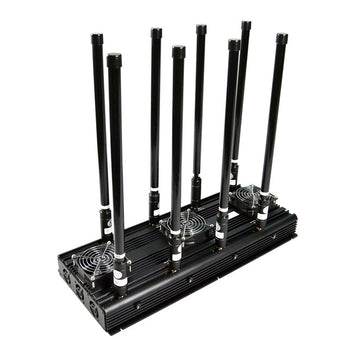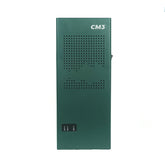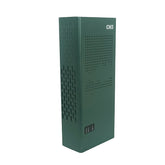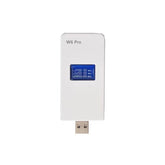Do cell phone jammers work? How to allocate radio frequency bands
First of all, what we want to say is that cell phone jammer are very useful in some places where they are needed? The radio frequency band is divided into many discontinuous frequency bands from low frequency to high frequency. Commonly used are HF frequency band, VHF frequency band and UHF frequency band. The microwave frequency band with higher frequency is only used for amateur satellite communication and microwave communication experiments. The following is a brief introduction to the propagation laws of the commonly used amateur radio bands.
2.80m frequency band (3.50~3.90MHz)
The propagation law of this frequency band is similar to that of the 160m frequency band, and it is mainly based on the mixed propagation of the F layer and the E layer. In summer and daytime, due to the high electron density in the D and E layers, the radio waves below this frequency band will be absorbed and cannot be reflected by the ionosphere. During the day, only 100-200km distance can be communicated. At the same time, thunder and lightning often occur in summer, so that there is a lot of noise on the frequency band, and weak signals cannot be heard. In the evening or dawn in winter, the effect of long-distance communication is better than that of the 160m frequency band, and the chance of connecting to a long-distance radio station is also greater. The antenna in this band is also relatively large, but it has been much smaller than the antenna in the 160m band. Besides, there are also many shortened product antennas, which makes it easier to set up an antenna in this band. Generally, it is simple to erect multi-purpose horizontal half-wave dipole antennas. The shortened products are mostly vertical grounded antennas. With a large erection site and sufficient funds, a huge Yagi directional antenna can be erected on an iron tower of tens of meters. !An antenna with good effect should be set high and long enough.
1.160m frequency band (1.80~2.00MHz)
This is the lowest frequency band allowed for amateur radio stations. The propagation law of this band is very similar to that of medium waves. During the day, ground waves are mainly used for short-distance communication, and at night, long-distance communication can be carried out through the reflection of the ionosphere D layer. The best communication timing is double communication.
Fangdu is at the junction of sunrise and sunset. In the evening or dawn in winter, it is time to use the 160m band for long-distance communication. Because the frequency of this frequency band is relatively low, a huge antenna needs to be erected, and the ionosphere has a relatively large attenuation to it, and requires a large power to achieve long-distance communication. Therefore, fewer people operate, and CW is used for communication.
The 4.20m frequency band (14.00-14.350MHz) is the famous DX (long-distance communication) frequency band, because this frequency band mainly relies on the F layer of the ionosphere for global communication. The characteristics of this band are that the propagation is relatively stable, the solar activity and seasonal changes have relatively little influence on the propagation, and the ionosphere is open for a long time. In winter, the transmission is slightly worse, and the transmission is mainly opened in Southeast Asia. In the spring and autumn, the global transmission is opened. In the summer, there is the possibility of DX communication even during the day. Most international competitions and radio expeditions can operate in this frequency band, and most of the radio stations using this frequency band are also for the purpose of DX communication. Therefore, this frequency band is the best frequency band for hunting rare radio stations. The most famous one in China is the China Old Ham Network with a frequency of 14.180MHz. For decades, the Chinese old hams in Southeast Asia gather at this frequency every morning, which is called morning tea gathering. The other is the China Radio Sports Association (CRSA) network on the 14.330MHz frequency. It is controlled by BY1PK at 10:00 am every Tuesday, and informs about the activities of various places and the recent work arrangements of CRSA. In addition to the commonly used CW and USB communication modes, this frequency band can also carry out RTTY and SSTY communication. Antennas in this frequency band can already be made relatively small, and Yagi directional antennas are often used, and the gain of the antenna is relatively high, and many of them use multi-band shared antennas for operation.
The 3.40m frequency band (7.00-7.10MHz) is one of the entry-level frequency bands for beginners, and it is also the most crowded and lively frequency band. The operating range of this frequency band is relatively narrow, but QSO can be carried out almost all day long. During the day, hundreds of kilometers of communication can be carried out. In the evening or dawn, it is a good opportunity to open long-distance communication. The frequency bands are crowded with each other, coupled with the serious noise in their own frequency bands, they are combined into a bustling market map. In the middle of the night, it is often a good time for intercontinental communication. Therefore, HAM, which often hunts rare radio stations in this frequency band, has the reputation of "night owl". Many HAMs in China use LSB to communicate between 7.050 and 7.070 MHz, and many provinces also set up fixed local networks on certain frequency points. Antennas of this frequency can be fun whether it is a simple dipole antenna, a vertical ground antenna, or a complex Yagi rotating directional antenna. Some people even clip the shortened whip antenna to the car and cross the continent on the way to and from get off work. Provincial communication.

5.15m frequency band (21.00~21.450MHz)
This is another entry-level band for shortwave beginners, and a good DX band. This frequency band is mainly reflected by the F2 layer of the ionosphere. Changes in solar activity, day and night, and four seasons have a greater impact on this frequency band. When the solar activity is relatively active, this frequency band is the main frequency band for DX contact, but at low solar activity period, it is more difficult to carry out long-distance communication. In spring and autumn, America can be opened in the morning, Oceania and Southeast Asia can be opened in the afternoon, and Europe and Africa can be opened in the evening. Most international competitions and radio expeditions can operate in this frequency band. The background noise in this frequency band is relatively small, and the antenna size is relatively small, so DX communication can be carried out with low power. Therefore, even in the narrow antenna erection conditions such as apartment buildings in the city, it can meet the requirements, even in the balcony or window extension The antenna can also be used for DX communication. At the same time, there are also many HAMs that use this frequency band for mobile applications. During holidays, simple antennas are erected in the wild to enjoy nature and enjoy the fun of DXQSO. In this frequency band, 21.400MHz is the calling frequency of Chinese amateur radio amateurs. Many Chinese HAMs are listening here, and many foreign radio stations specially call Chinese radio stations on this frequency. This frequency is fixed and used as DX, and high-gain Yagi rotating directional antennas are mostly used. Because the wavelength is short, the antenna is relatively easy to make, so many beginners use the homemade antenna for communication.
7.6m frequency band (50.00~54.00MHz)
This is the famous Beginner Band, also known as the "Magic Band". The main reason is that the propagation characteristics of this band are between HF and VHF. During the active period of solar activity, the phenomenon of sudden E ionosphere propagation will occur. The abnormal propagation of radio waves through the sudden E ionosphere can be carried out with very little power. Global DX Communications. It is a band that DX enthusiasts are curious about. At the front end of this band, amateur radio organizations have set up beacon stations all over the world. These beacon stations transmit beacon signals in turn 24 hours a day. We only need to receive beacon signals from these beacon stations. You can understand the opening of the band in real time, and some enthusiasts can explore the magical law of the occurrence and propagation of the sudden E ionosphere by listening to and recording the signal conditions of these beacons. The well-known calling frequency in this frequency band is 50.110MHz. Many DX hunters in the 6m frequency band are in ambush here. This frequency band has a shorter wavelength and is suitable for experiments with antennas and circuits. Now there are more products of hand-held walkie-talkies in this band, making portable mobile applications possible. I have heard that AM can use a 3W small mobile phone to communicate with Japanese radio stations at the door of their own home. What a magical experience.
6.10m frequency band (28.00~29.70MHz)
This is the highest frequency band of the short-wave band, and it is also the widest frequency band of the short-wave medium frequency band. The propagation characteristics of this band are between HF and VHF. The ionospheric attenuation of the open propagation is small, the frequency noise is small, and the antenna gain is easy to be increased. When there is no reflection in the ionosphere, it can only be used for line-of-sight propagation. When propagation is turned on, unexpected long-distance communication is possible with very little power. Another feature of this frequency band is that it is the only frequency band that can use FM in the HF frequency band. Once the FM signal is greater than the receiving threshold, it has very good anti-interference performance. Due to the function of the limiting circuit, the signal-to-noise ratio and sound quality of the signal are very good Well, the FM transceiver is also easy to make and adjust, and the production success rate is very high. Therefore, it is very suitable for beginners to start homemade. The 29.600MHz frequency is an international FM calling frequency. Many FM enthusiasts in the 10m frequency band at home and abroad use FM for communication. When the communication is opened, it is very lively. This frequency mostly uses high-gain directional antennas and various vertical antennas, and the HAM using self-made antennas is not small.
8.2m frequency band (144.00~148.00MHz)
This is a typical VHF band, a very active band for local mobile communications. There is basically no reflection on the ionosphere of the signal in this frequency band. The radio wave is mainly transmitted by the direct wave line-of-sight. During the transmission, there are buildings or mountains, etc., which will generate reflected waves. Therefore, it can only be used as short-range communication. This is to carry out amateur satellite communication and lunar reflection communication experiments for long-distance communication. Antennas in this frequency band are the most produced by amateurs. There are various high-gain directional and omnidirectional antennas, vehicle-mounted mobile whip antennas and small handheld antennas.
10.0.23m frequency band (1260.00~1300.00MHz)
This frequency band basically belongs to the microwave frequency band, mainly in the form of direct wave propagation, but amateur radio amateurs use this frequency band to conduct ultra-distance communication experiments such as meteor trail reflection and tropospheric scattering. In addition, there are also satellite communications through amateur communication satellites. experimental. Since the frequency of this frequency band is relatively high, the water vapor and raindrops in the air will attenuate the radio waves, and at the same time, the loss of the transmission cable and the cable plug connector will also be large. Fortunately, due to the short wavelength, it is easy to use antenna arrays or parabolic antennas to make high-gain antennas. Because the frequency band of this frequency band is very wide, in addition to regular communication, it can also conduct experiments on amateur digital communication and amateur TV communication.
9.0.7m frequency band (430.00~440.00MHz)
It belongs to the UHF frequency band, the direct wave propagation is more severe than the 2m frequency band, and the reflection and refraction phenomena are more obvious than the 2m frequency band, but at the same time, the attenuation of the air is larger than that of the 2m frequency band, so it is not suitable for long-distance communication. When using longer cables, start to consider the attenuation of the signal caused by the cable. Due to the high frequency and low noise in this frequency band, and various manufacturers are competing to launch a variety of small and full-featured antennas that can be made smaller and can be installed in cars, mobile communications in this frequency band are very active. In order to solve the problem of short communication distance, many amateur radio amateurs set up the repeater at a high place. With the help of the repeater to transfer the signal, the communication range can be greatly increased. Remote radio station QSO. In summer and other seasons with unstable weather, an abnormal propagation phenomenon called "atmospheric duct" often occurs. The radio waves are refracted back and forth between the three layers of the atmosphere with sudden temperature changes, and the attenuation is very small and transmitted to the distance. There are also phenomena such as meteor trail reflection and tropospheric scattering, which will also cause the propagation of radio waves in the 2m frequency band beyond the horizon. The radio waves in this band can pass through the ionosphere. In recent years, car radios and small mobile phones have gradually replaced the 2m band and become the main local mobile communication band. Combined with the erection of high-performance repeaters, a good local communication network can be formed. .
This frequency band can carry out communication experiments such as meteor trail reflection, tropospheric scattering, lunar surface reflection and amateur satellite communication. Especially in recent years, several high-orbit high-power amateur radio satellites have been launched successively, which prolongs communication time and facilitates tracking. Antenna requirements Simplicity, reduced equipment requirements, and ease of use of satellite communications, thus increasing the number of participants. In order to adapt to mobile communication, most of the antennas in this frequency band are mainly vertically polarized antennas. Many manufacturers have introduced various dual-band antennas shared by 144/430MHz to facilitate communication between amateur radio amateurs between the two frequency bands.













